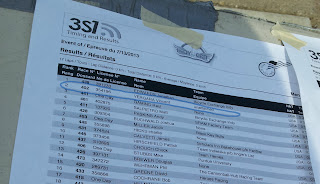I want to start off by saying that I am not sponsored by Kestrel, but wanted to write this review to share my awesome experience with it. My Kestrel Talon took me to my first podium finish and win as well as many others afterwards.
KESTREL EMS PRO SEATPOST + RITCHEY CLAMP SYSTEM = "A BIKE FITTERS DREAM"
What made the Talon most impressive was its ability to adjust saddle tilt and the seatpost angle with extreme accuracy via the saddle mount. By being able to dial in the bike fit, I could handle any ride or race efficiently. If I knew a race was going to be fast like the Indy Crit (~27 mph average), I could shift the seatpost angle two degrees forward to make the aero position more comfortable. In contrast, I could easily move the seatpost angle backwards and reduce saddle tilt to make hilly courses more comfortable.
The icing on the cake was the ease of saddle adjustments. In less than a minute, I could adjust my saddle tilt to the exact degree I wanted via a single bolt. This technology needs to become a standard in all seatpost! I never had an overuse injury on this bike because my bike fit was perfect! Did I mention that I unintentionally finished my first century in less than 5 hours and 18 minutes on my Kestrel Talon? Most of the time was spent in an aero position on the drops. Check out my century ride on Strava:
My First Century: http://www.strava.com/activities/62111528
2013 CRITERIUM RACE RESULTS
The Kestrel Talon was more than capable to produce podium finishes at various course profiles. Out of six races, it carried me to four podium finishes. It was stiff enough to win an uphill sprint finish
(Eagle Creek), agile enough to manage the tightest corners (Mass Ave Criterium State Championship) and aerodynamic enough to bridge a gap in the fastest criteriums (Indy Crit 27mph average speed). Many of these races had fields of over 80 riders which awarded me the option to upgrade to Pro 3. All of my races were uploaded to Strava, so feel free to check them out AND don't forget to follow me!
Eagle Creek Traditional Criterium (First Place):
Indy Crit (2nd Place):
Bloomington Criterium (3rd place):
Mass Ave Criterium State Championship (2nd Place):
SHORT WHEELBASE = CRISP, FAST HANDLING
Coming from a sports car racing background, I knew the Kestrel Talon would be awesome in criteriums. With a wheelbase shorter than most road bikes, I could appreciate the ride characteristics that comes with a short wheelbase. Whenever I would find myself needing to change my line after breaking away off the front, I could do it without hesitation. The sensation was similar to a skier cutting into the snow to change direction quickly. This was especially useful for avoiding crashes!
GOODBYE KESTREL TALON
Unfortunately, I was forced to stop riding my Kestrel Talon after I was sent crashing to the ground at 33mph when my new, but defective Continental GP4000S tire ripped apart after I made a solo attack and reached 33mph. I fell on my back, shoulder and head which gave me a concussion. The strains and sprains at my neck, shoulder and abdomen were just as bad as the road rash that riddled my body. If you get grossed out easily, don't look at the pictures below. I had road rash on both shoulders, one side of my abdomen, both arms and both legs. Please stop riding Continental GP4000S tires until they announce that they resolved these defects in their tires. My tires had no sidewall bubbling when they completely failed. Check it out:
All I have now are pictures and videos of my Kestrel Talon. It was a great bike and I would highly recommend it to anyone looking for a comfortable, high performance bike for racing and training on the road. If I could afford another one, I would definitely go back to it!
VIDEOS
The video below was a lap comparison around the Marian University Criterium route. I was experimenting with different pacing strategies around the ~2 mile loop to determine where I would want to attack, conserve, etc..
The only weak spot in the build were the Oval Concepts 524 wheels. They were very flexible in the sprints. The video below demonstrates the excessive amount of lateral flex the wheels had. The wheelset seemed to be more appropriate for tempo efforts and not accelerations or sprints.
To ensure that the wheel was flexing and not the frame, I compared the Oval Concepts 524 wheel to an Alex Rims 32 spoke wheel and retested it for flex. Result? The 32 spoke wheel showed almost no flex or deflection. After seeing the video, I worked with my sponsors at Velocity Wheels and The Wheel Department to hand build a light racing wheelset with the same stiff build characteristics as the Alex Rims wheel.
UPDATE: 2013 USA CYCLING REPORT ON KESTREL
I was surprised to hear that in a 2013 USA Cycling report, only ~2% of registered riders own a Kestrel. Although Kestrel is known for their high end triathlon bikes, cyclists should really consider it for criterium or road racing. I was glad to represent the small minority through some strong results in 2013!





























































